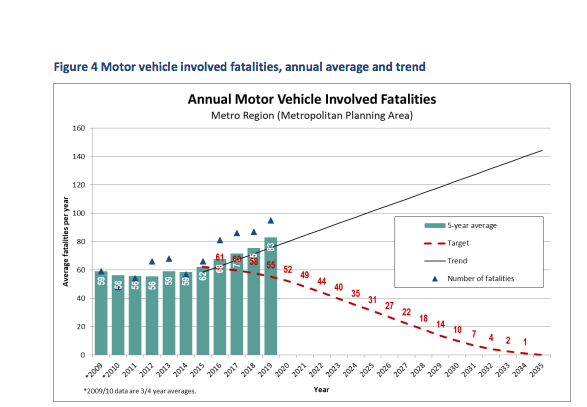Vision Zero is a popular and widely embraced safety campaign, but the latest data shows Portland is not only not on track, it’s going in the wrong direction when it comes to road safety
Multi-lane, car-dominated urban arterials are the big killers, and instead of fixing them, the Oregon DOT is wasting billions on widening extremely safe freeways
Cheaper gas since 2014 has fueled more driving, more crashes and more deaths. Vision Zero isn’t working.
Portland’s regional government, Metro, does a thorough job of tracking and compiling road safety measures. Its latest report, including data through the end of calendar years 2019 tracks progress against the region’s adopted “vision zero” goals.
Portland area road deaths: Rising when they’re supposed to be falling.

Metro calculates progress using the five-year moving average of the number of roadway fatalities in the Metro planning area. The vision zero plan, incorporated in the 2018 Regional Transportation Plan, calls for that to trend down to zero by 2035, and the dashed red line shows the progress that would be needed to achieve that objective. But as the 2015-2019 trend (solid black line) shows, the region is moving in the wrong direction at an accelerating pace. The blue rectangles show the five year moving average (e.g. 2019 is the average of the deaths for 2015 through 2019). The small blue triangles corresponding to the actual number of road deaths in each year. In 2019, the five year moving average was 83 deaths, the actual number of deaths was 95, and the Vision Zero plan called for a reduction to 55 deaths.
The tragic topline numbers of fatalities, if anything understate the region’s comprehensive failure to make progress on Vision Zero. Metro tracks 25 separate measures of system safety, such as fatalities and injuries for different road users in the aggregate, and per capita or per million miles traveled. Metro’s annual report shows that the region is on-track to make exactly none of these 25 objectives, and has made improvements from 2015 levels on just two (both related to bike safety).
Deadly arterials are the big problem
Periodically, Metro undertakes a “State of Safety” Report that looks at these data in greater detail through the lenses of different geographies and road types. Their latest report confirmed earlier findings. Multi-lane arterials are far and away the largest sources of deadly and injurious crashes. These roadways create inherent conflicts between vehicles, bikes and pedestrians; high speeds and multiple lanes result in more crashes, injuries and deaths. On average, the region’s arterials have five times as many serious crashes per mile traveled as freeways, according to the Metro study, a finding they called “one of the most conclusive relationships in this study.”
This same pattern holds nationally. A recent national study looked at every major road segment in the nation and identified the 65 of the worst pedestrian crash hot-spots, places that had eight or more pedestrian fatalities in a 1,000 meter road section in an eight year period. These hot spots, really killing zones, shared a series of common characteristics:
Nearly all (97%) were multilane roadways, with 70% requiring pedestrians to cross five or more lanes. More than three-quarters had speed limits of 30 mph or higher, and 62% had traffic volumes exceeding 25,000 vehicles per day.
Schneider, R. J., Sanders, R., Proulx, F., & Moayyed, H. (2021). United States fatal pedestrian crash hot spot locations and characteristics. Journal of Transport and Land Use, 14(1), 1-23. https://doi.org/10.5198/jtlu.2021.1825
Cheap gas = More roadway deaths
Importantly, as we’ve pointed out at City Observatory, the surge in traffic deaths has a lot to do with the big decrease in gas prices in 2014. Up until 2014, Portland area traffic deaths averaged (over five years) was less than 60 per year. Since 2015, the five year average has exceeded 60 deaths per year every year, and is increasingly rapidly.
ODOT is squandering billions on freeway widenings that are unrelated to the rising death toll
While the region continues to fail to make progress on reducing crashes and associated deaths and injuries, the Oregon Department of Transportation continues to move ahead with plans to plow billions of dollars into widening area freeways, which are far and away safer than these deadly arterial streets. ODOT operates many of the region’s most deadly arterial roadways, including Powell Boulevard, Barbur Boulevard, 82nd Avenue, the Tualatin Valley Highway and McLoughlin Boulevard. ODOT has falsely claimed that the Rose Quarter I-5 freeway which it is widening at a cost of nearly $800 million, has the “highest crash rate in Oregon”. This stretch of freeway chiefly has minor “fender bender” crashes, and is classified by Metro as a “minor safety project.”
Vision Zero is threatening to become yet another empty marketing campaign; a slogan that simulates concern while allowing business-as-usual—meaning increasing carnage—while providing cover for the highway lobby to squander additional billions of dollars on so-called improvement projects that do little or nothing to reduce growing toll of deaths and injuries on our roads. Metro’s check-in on safety metrics shows our current efforts are failing. What will the region do to show that its serious about improving safety?
